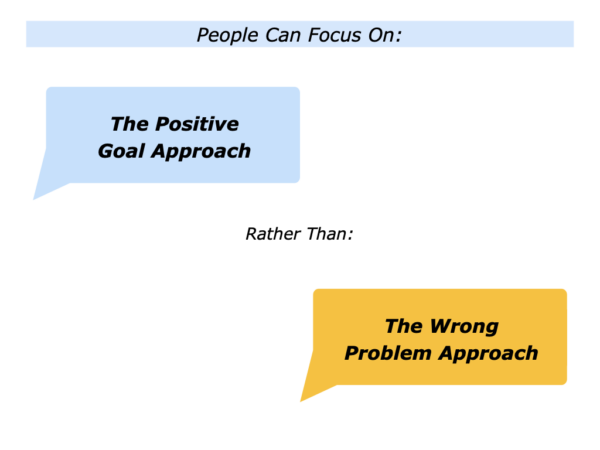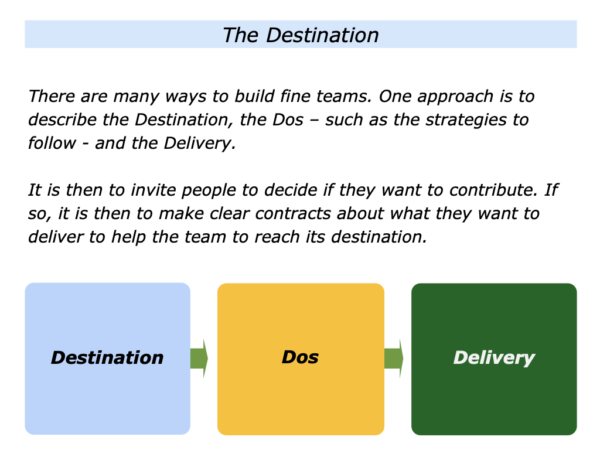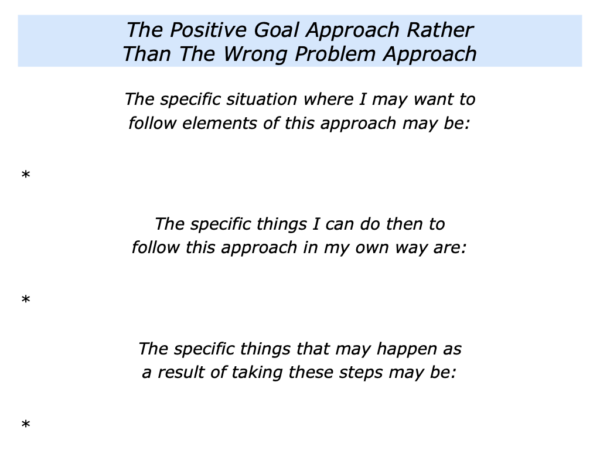
There are many ways to do fine work. One approach is for people to focus on trying to achieve the positive goal rather than trying to solve the wrong problem.
Good decision makers take this approach. They focus on the real results to achieve – the positive goal – and translate these into a clear picture of success.
Some decision makers take a different approach. They focus on fixing a certain problem. Sometimes this may be necessary. But it may or may not help to achieve the big positive goal.
There are many ways to focus on the positive goal rather than tackle the wrong problem. Let’s look at one of the most common ways to follow this principle.
The Effectiveness Approach Rather
Than Just The Efficiency Approach
Many organisations aim to be more efficient but this approach comes with a caveat. Some organisations may not focus on the right goals. They may simply being more efficient at climbing the wrong mountain.
Good organisations focus on being effective. They start by clarify the real result to achieve – the right goals. They then implement the right strategies with the right people in the right way.
Great workers follow a similar approach. They aim to achieve effectiveness plus efficiency to deliver excellence. Bearing in mind the real results they want to achieve, they focus on the following themes.
Effectiveness
They clarify the key strategies they can follow to give themselves the greatest chance of success.
Efficiency
They follow the key strategies in the most efficient way whilst continually checking what is working and what can be improved to achieve success.
Excellence
They continue to pursue the effective strategies in an efficient way and deliver excellence on the way towards achieving success.
Looking back, I remember one workshop where the CEO expressed their concern regarding these themes. They expressed this in the following way.
“I am a bit worried that we may have fallen into the trap of aiming to be efficient but not actually focusing on being effective. We may need to go back and make sure we are aiming for the right goals in the right way.”
The CEO and their leadership team clarified the real results to achieve in various situations. For example, when making a pitch to a potential client they focused on the outcomes they wanted to achieve. These were:
To start by showing that their company understood the client’s goals;
To show how the company could use its strengths to help the client to achieve their goals;
To deliver a wonderful pitch that increased the chances of the client hiring the company to help them to achieve their goals.
The CEO also appointed a Mission Holder who would coordinate the company’s resources and people to deliver a great pitch. That person made sure everything was done to increase the likelihood of working with the potential client.
Let’s return to the theme of focusing on the positive goal rather than tackling the wrong problem. Here are some examples of how people have applied this approach in their personal and professional lives.
The Strengths Approach Rather Than
The Fitting Into The System Approach
During one mentoring session a parent asked how to help her son to do better at school. She explained this in the following way.
“My fifteen-year-old son is dyslexic and also has ADHD. I would like him to pass the exams required to get into university. He struggles to do this, however, and I am uncertain if he will get in.
“Looking back at my own life, going to university helped me a lot. Being away from my family helped me to shape my future. It also gave me some friends for life. I would like him to have the same opportunity.
“My son has a short attention span, however, and sometimes gets impatient with the teachers. We have hired private tutors but this does not seem to help. Have you any suggestions to help him with his studies?”
Bearing these things in mind, I asked about her son’s strengths. What did he enjoy doing? When did he come alive? What were the activities in which he showed self-discipline?
We explored these themes. At first she found it hard to clarify her son’s strengths but then went on to give some clues. These provided some obvious ways forward. Here is a summary of what she described.
“Two years ago we went to Egypt. He spent a lot of time – and a lot of his money – in the markets. He bought lots of leather wallets and purses which he then sold to his friends.
“He invested the earning in buying lots of different things which he again sold at a profit. Recently he has started a Saturday job in a local vinyl record store. He talks about wanting money in his pocket rather than going to university.”
Her son was a trader. He loved to buy, sell and make money. He was also good at it. This gave him a feeling of success and self-confidence. The opposite of what he got in school.
After some discussion we clarified the positive goal. This was to help her son to develop the ability: a) to build on his strengths; b) to do satisfying work; c) to earn a good salary.
There was little point in trying to fix the wrong problem. Certainly he could be helped to develop some skills to help him pass exams, but he was a pragmatist. He needed to see the point of what he was learning and then be able to apply it.
Some people will say that the solution was obvious – it was vital to build on the son’s strengths. At the same time, it was important to recognise his mother’s had good intentions. But maybe these were focusing on trying to solve the wrong problem.
The son went on to set up his own business selling goods on the internet. He then took a sales role in a high tech company but also continued to have several websites which provided him with an ongoing income.
The Destination Approach Rather
Than The Change Approach
The CEO of a company faced a challenge that also called for shifting elements of the culture. He explained the situation in the following way.
“We have moved from being a relatively small business to one that now has over sixty people. We still provide good products but have expanded too quickly and also made mistakes by over-hiring.
“Some of our staff seem more intent on pursuing their own agendas rather than providing great service to their internal and external customers. This has resulted in internal conflicts and losing customers.
“Maybe it is our fault. We need to improve our recruitment and induction to make sure we get people who are service-minded. But that does not solve the immediate challenge.
“Yesterday I met the leaders of two specialist functions. They seem more interested in protecting the work of their own departments rather than focusing on the company’s goals.
“I have tried to change their mindsets but have not succeeded. They seem more intent on following their own departments’ processes rather than providing great service. Have you any suggestions?”
The CEO and I explored the possible options going forwards. The approach we chose was:
To focus on the positive goal – the company’s picture of success – rather keep trying to get the two leaders to change their mindsets.
The CEO and I explored how to communicate the company’s picture of success to the leaders. It would then be up to them to decide if they wanted to contribute. This involved taking the following approach.

There are many ways to build fine teams. One approach is to describe the following things to people.
The Destination – the team’s goals and the benefits of achieving the picture of success;
The Dos – the strategies people can follow to do their best to reach the destination;
The Delivery – the specific things that need to be delivered – and by when – on the way to reaching the destination.
The next step is to invite people to take time to reflect and decide if they want to contribute. If so, it is then to make clear contracts about their best contribution towards helping the team to reach the destination.
The CEO took this approach when holding individual sessions with the two leaders. Here is the framework they used to invite each of them to decide if they wanted to contribute towards helping the company reach its destination.
The Destination
This is the destination. The outcomes
we aim to achieve as a company are:
* To
* To
* To
The benefits of reaching
this destination will be:
* To
* To
* To
The Dos
Here are some of the Dos to follow that will give us
the greatest chance of reaching the destination.
* Do
* Do
* Do
The Delivery
Here are some of the things that we aim to deliver
– and by when – on the way towards the destination
*
*
*
The CEO emphasised the importance of each department focusing on the company’s goals. This included giving good service to both their internal and external customers.
The individual sessions had mixed results. One department leader agreed to keep focusing on the big picture. They also ensured their department would proactively keep others informed about their progress towards making their contribution to the company’s goals.
The other department leader adopted a different position. They reiterated why their people followed their certain processes. They wanted to protect their department’s way of working rather than take another approach.
The CEO recognised the department’s expertise. But they wanted the staff to channel this towards achieving the company’s goals rather than their present aims. This would not happen under the present leadership.
Bearing this in mind, the CEO took they following steps. They replaced the present leader with somebody who, to use the well-known phrase, was:
A leader of experts rather than an expert who had been appointed as a leader.
The new departmental leader took they following steps. They were able: a) to establish credibility in their own way; b) to coordinate the strengths of each person to work towards the company’s goals; c) to deliver the desired concrete results.
The CEO helped the company to continue to achieve success. They did this by focusing on the positive goal which, in the process, also helped to solve the original problem.
The Positive Goal Approach Rather That
Rather Than The Wrong Problem Approach
There are many ways to apply this approach. Some people follow it, for example, when aiming to build a healthy society. They do practical work that focuses on helping people to maintain or improve their health, hope and happiness.
Some people – such as politicians – do not follow this approach. They prefer instead to focus only on the symptoms of failing to create a healthy society. This produces mixed results.
Let’s return to your own life and work. Looking ahead, can you think of a situation where you may want to focus on the positive goal rather than the wrong problem? How can you do this in your own way?
If you wish, try tackling the exercise on this theme. This invites you to complete the following sentences.



Leave a Reply